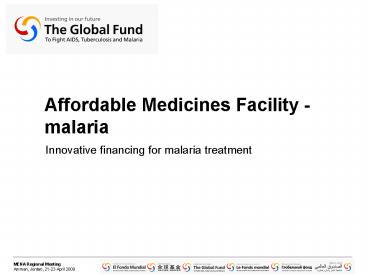Affordable Medicines Facility malaria - PowerPoint PPT Presentation
1 / 12
Title:
Affordable Medicines Facility malaria
Description:
WHO recommends artemisinin-based combination therapies (ACTs) but they: ... Source: Biosynthetic Artemisinin Roll-Out Strategy, BCG/Institute for OneWorld ... – PowerPoint PPT presentation
Number of Views:39
Avg rating:3.0/5.0
Title: Affordable Medicines Facility malaria
1
Affordable Medicines Facility - malaria
- Innovative financing for malaria treatment
2
What is the problem?
- In 2006, approximately 250 million people
contracted malaria and nearly one million people
died, mostly children - Malaria parasites increasingly resistant to
older, cheaper treatments, such as Chloroquine
(CQ) and Sulfadoxine-Pyrimethamine (SP) - WHO recommends artemisinin-based combination
therapies (ACTs) but they - Are unaffordable compared with CQ and SP
- Account for only 1 in 5 anti-malarial treatments
taken - Have very limited availability in the private
sector - Furthermore
- Artemisinin monotherapies increase the risk of
resistance
3
Limited availability of ACTs
Note Other category includes Mefloquine,
Amodiaquine and others. ACT data based on WHO
estimates and manufacturer interviews. Source
Biosynthetic Artemisinin Roll-Out Strategy,
BCG/Institute for OneWorld Health, WHO, Dalberg.
4
High average ACT prices
Note Ranges indicate variance across countries
and products excluding outliers N
(observations) (ACT, 222) (AMT, 227) (CQ, 37)
(SP, 118).
5
AMFm - Goals and Objectives
- Goal 1
- Contribute to Malaria Mortality Reduction
- Goal 2
- Delay Resistance to Artemisinin
- These goals will be achieved by
- 1 Increasing affordability of ACTs
- Price equivalent to or lower than CQ/SP
- 2 Increasing availability of ACTs
- Scale up through public, private, NGO sectors
- 3 Crowding out artemisinin monotherapies
- Decrease likelihood of artemisinin resistance
6
From idea to policy and practice
- Original idea from Institute of Medicine
Committee Report (Prof. Kenneth Arrow and
others, 2004) - Designed by unprecedented global coalition
- RBM Board invited the Global Fund to host and
manage AMFm (November 2007) - Board of the Global Fund decided to host and
manage AMFm (November 2008) - Global Fund Secretariat now preparing to launch
Phase 1
7
AMFm How does it work?
- Negotiations with manufacturers to reduce price
of ACTs - Co-payments to manufacturers to further reduce
price of ACTs - End-user ACT prices become similar to
less-effective drugs - Market dynamics to encourage ACT distribution and
use - Supporting interventions to ensure safe and
effective ACT scale-up
8
AMFm will reach all sectors
Multiple eligible ACT manufacturers
Co-payment
First line buyers
Private Buyers
NGO Buyers
Public Buyers
Central medical stores
Wholesalers
Distributors
Medicines
Money
Retailers, private clinics and public providers
Patients
9
AMFm supporting interventions
- Supporting interventions to ensure safe and broad
access to ACTs - Countries must implement the following
activities - Public education and awareness campaigns
- Training, monitoring and supervision for ACT
providers - Planning for national policy and regulatory
preparedness - Planning for monitoring of drug quality
- Interventions to reach the poor and other
vulnerable groups
10
What will AMFm mean for countries?
- Access to affordable ACTs
- Impact on malaria mortality
- Significant financial savings to patients
- Safe and broad scale-up
- Supporting interventions to strengthen the health
system - Open platform
- Public, NGO and private sector programs will
benefit - Alignment with existing Global Fund systems
- Builds on grant programmes to further expand
access
11
AMFm Phase 1
- Phased launch to learn lessons in 11 countries
- Benin, Cambodia, Ghana, Kenya, Madagascar, Niger,
Nigeria, Rwanda, Senegal, Tanzania, Uganda - Supported by robust monitoring and evaluation
- Including independent evaluation
- Strong financial support from donors
- UNITAID pledged up to 130 million for co-payment
- DFID pledged 40 million for co-payment
- Operational for 24 months
- Implementation begins following Global Fund Board
meeting in November 2009
12
Towards global roll-out
- Board will decide whether to proceed to global
roll-out - Decision expected in 2011
- Expansion to global roll-out anticipated unless
clear failures observed - AMFm in all malaria-endemic countries































